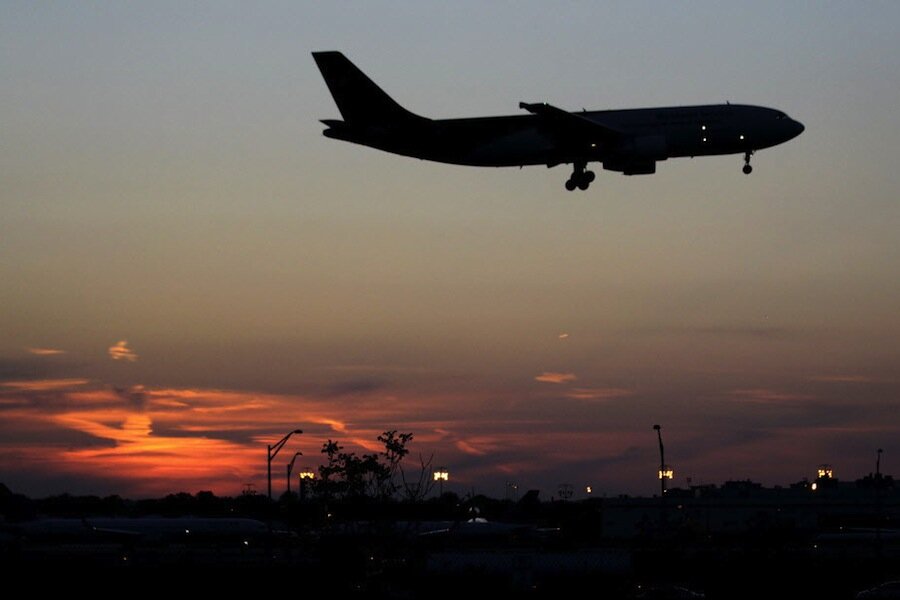Next target for EPA climate rules? Airlines
Loading...
| Washington
When it comes to finding new ways to cut emissions, the sky’s the limit.
As early as Friday, the US Environmental Protection Agency will announce its finding that airline emissions harm human health by exacerbating climate change. Then, under the Clean Air Act, EPA will have the authority to issue new regulations slashing airline industry pollution.
EPA told the Monitor Wednesday that its airline findings will be posted online for comment after they have gone through interagency review, but EPA did not provide a date. The imminent release of EPA's rules was first reported Tuesday by Reuters and the New York Times.
The 1970 Clean Air Act requires the federal government to regulate pollutants that experts say impact public health, like mercury, carbon monoxide, and lead. And as human-driven climate change becomes an increasing concern for the Obama administration, EPA is deploying that authority to slash planet-warming carbon dioxide emissions.
The move to stanch emissions from airplanes is the latest in a series of controversial, executive-led maneuvers to combat climate change. Last summer the president rolled out a proposed EPA rule that would cut power plant emissions 30 percent by 2030. Obama has also moved to curtail emissions from cars and trucks.
As part of its contribution to global climate efforts, the US has pledged to cut emissions across the economy by 26 to 28 percent below 2005 levels by 2025.
Republicans on Capitol Hill and many in the emissions-intensive fossil fuel industry feel Obama’s actions overstep his executive authority. Senate Majority Leader Mitch McConnell (R) of Kentucky has even encouraged states to ignore EPA’s new power plant rule all together, while Republicans and industry challenge it in court. So far, Obama’s climate regulations have held up to judicial scrutiny.
Airplanes represent 11 percent of emissions from the US transportation sector, and 3 percent of total US emissions. And while greenhouse-gas emissions from cars and trucks have been regulated for years, airlines have largely flown under the radar of climate rules. The transportation sector makes up more than 25 percent of US greenhouse emissions, according to the US Environmental Protection Agency – second only to power plants.
“We have efficiency standards for cars, trucks, but we don’t have one for airplanes,” Annie Petsonk, international counsel for the Environmental Defense Fund, an environmental group, told Reuters Tuesday. “We think this is an industry that has great potential in technical terms, and there is nothing like having an ambitious standard to drive innovation.”
For industry, what’s important is that US guidelines conform with international emissions-cutting rules that the United Nations' International Civil Aviation Organization is in the process of hammering out.
“As aviation is a global industry, with airlines and aircraft operators operating internationally and aircraft manufacturers selling their aircraft in international markets, it is critical that aircraft emissions standards continue to be agreed at the international level,” Melanie Hinton, a spokesperson for industry group Airlines for America, said in a statement to the Monitor Wednesday.
But some environmentalists worry those international rules from ICAO won’t be strong enough to make a difference.
“Conforming to the international standards, if and when they come out, would be pathetic,” Vera Pardee, an attorney at the Center for Biological Diversity, an environmental group, said Wednesday. “There would be no actual reduction as this industry grows. Punting this responsibility over to ICAO is unacceptable.”
Because of increased air travel worldwide, airline emissions will triple by 2050 without regulatory action, according to the International Council on Clean Transportation. And even if airlines’ individual planes increase their fuel efficiency, the industry’s total emissions could still balloon as more and more planes take to the skies.
The airline industry points out that it has made progress, even without strict EPA regulations.
“The US airlines have a strong record of fuel efficiency and carbon emissions reduction, having improved their fuel efficiency by 120 percent between 1978 and 2014, saving 3.8 billion metric tons CO2,” Ms. Hinton added.
But for environmentalists, the prospect of the US putting in place bold emissions cuts – for example, requiring airlines to cut emissions for the entire fleet and not just on newer planes – would have global ramifications.
“If EPA steps up and sets emissions standards for the US, the world will have to follow,” Ms. Pardee said in a telephone interview, encouraging the Obama administration to go beyond simply adopting ICAO's standard.





